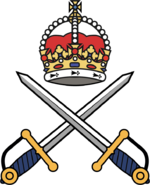Royal Army (Great Nortend): Difference between revisions
No edit summary |
No edit summary |
||
| Line 1: | Line 1: | ||
{{Infobox military unit | {{Infobox military unit | ||
|unit_name= Royal Army | |unit_name= Royal Army | ||
|image=[[File:GNArmy.png]] | |image=[[File:GNArmy.png|150px]] | ||
|caption= | |caption= | ||
|dates= 1455 — present | |dates= 1455 — present | ||
Revision as of 12:15, 17 March 2019
| Royal Army | |
|---|---|
 | |
| Active | 1455 — present |
| Country | Great Nortend |
| Allegiance | Alexander II |
| Branch | Army |
| Size | 23,388 (regular men), 10,482 (regular officers), 620,140 (national servicemen, yeomen and militiamen), 2,760 (half-pay officers) |
| Engagements |
|
| Commanders | |
| Commander in Chief | Alexander II |
| The King's Marischal | The Most Honourable Margrave of Lasmere |
| Captain of the Forces | Captain-General Sir John Haughton KSA KCMM |
| Insignia | |
| Flag | |
The Royal Army of Great Nortend is the major land and terrestrial warfare and defence fore for Great Nortend. It is known fully as His Majesty's Officers and Men at Arms, and consists of a number of separate semi-independent corps, compagnies, troops, and regiments.
History
The present Royal Army was first established in 1455 with the raising of the Duke of Aldesey's Regiment, which is now known as the 1st Regiment of Foot, the Royal Narland Regiment, by the then Duke of Aldesey in the Succession Wars after the death of Charles II in a hunting accident in January of 1455.
Structure
The War Office is the central administration body for the Royal Army, similar to how the Admiralty administers the Navy Royal, but does not itself command troops. Rather, the King's Marischal, a hereditary position held by the Margrave of Lasmere, has full theoretical command of the troops, subject to the King. In practice, the Captain of the Forces assumes direct command of the Army, based in Army House, in Lendert-with-Cadell. To the Captain of the Forces report seven officers, being the general staff officers in charge of the six regional commands and the Adjutant-General, in charge of administration. These staff officers hold the rank of captain-general or lieutenant-general. Subordinate to these are divisions, commanded by major-generals, and brigades, commanded by brigadier-generals.
The five major divisions of the forces are the infantry, the cavalry, the artillery, the engineers, and the services. Each has its own formation structure and to an extent, rank structure. Infantry, artillery and cavalry regiments and engineering battallions are all separate legal entities, as are each of the service corps, albeit established in accordance with the chain of command.
Most regiments (and battalions for engineers) are established on a regional basis, drawing in men and officers from amongst the subjects of a particular region. They are commanded by a colonel. There are presently 54 infantry regiments, 16 cavalry regiments, 15 artillery regiments and 14 engineer battalions. Most infantry and cavalry regiments have one regular army battalion, one national service battalion, and one militia (foot infantry), volunteer (rifles, artillery and engineers) or yeomanry (cavalry) battalion. There are talks to reduce the number of infantry regiments by around half, to 26, by amalgamating regiments; however, this has attracted criticism.
Personnel
National Service
Militia and Yeomanry
Ranks
Equipment
Dress
This page is written in Erbonian English, which has its own spelling conventions (colour, travelled, centre, realise, instal, sobre, shew, artefact), and some terms that are used in it may be different or absent from other varieties of English. |

